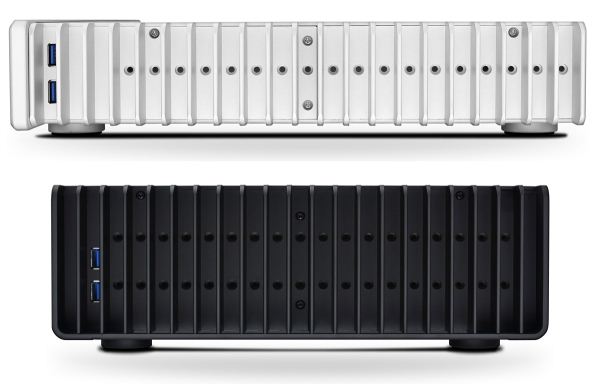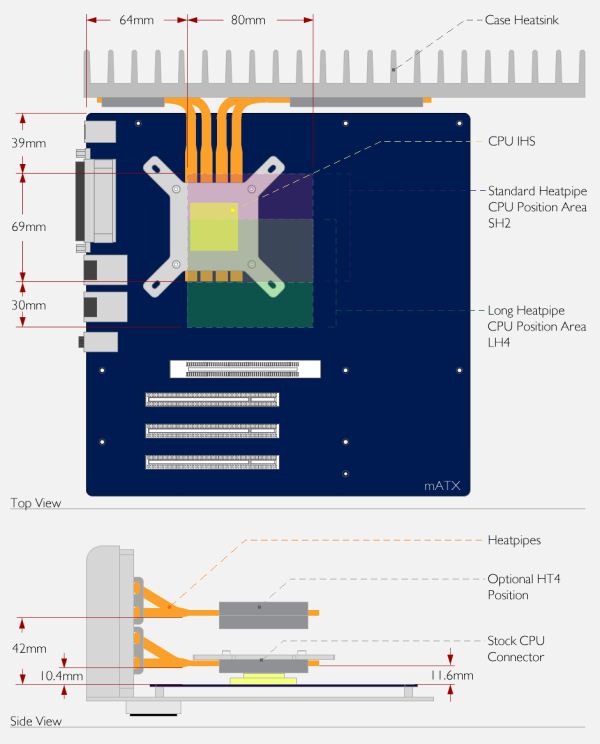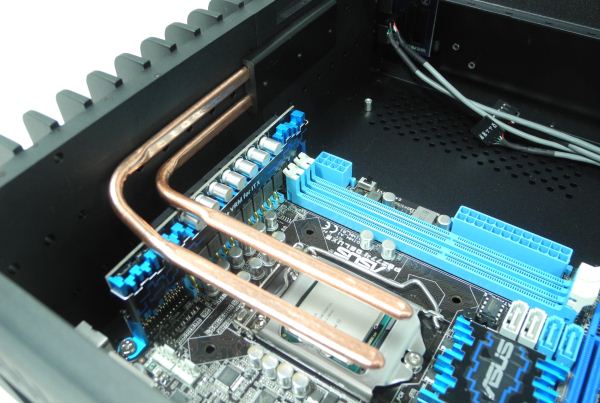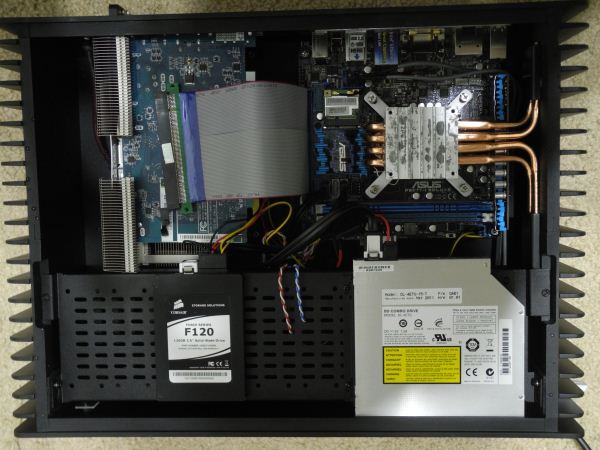Streacom's FC10 and Nano150: Building a Fanless Ivy Bridge HTPC
by Ganesh T S on December 22, 2012 3:30 AM EST- Posted in
- HTPC
- Fanless
- Ivy Bridge
Build Process
The FC10 chassis has limited external ports (only two USB 3.0 capable ports on the side panel other than the ODD button / power button and LED on the front panel). We don't have front panel audio, eSATA / Firewire ports or fancy LCD screens to connect to the main board. This is actually advantageous as it allows us plenty of room and resource efforts to direct towards assembling the cooling system. As we had mentioned earlier, Streacom is no newcomer to the fanless chassis bandwagon. In fact, their FC5 Evo Fanless chassis received good reviews. Unfortunately, the profile of the chassis, as well as the positioning of the screw slots for the heat pipe system meant that the choice of motherboards was extremely limited. Streacom touts extended motherboard compatibility as one of the strong points, and we were forced to test it out because of the design of the Asus P8Z77-I Deluxe motherboard.
Improved Motherboard Compatibility with Dual Heat Sink Mounting Levels in the FC10 (Bottom) Compared to the FC5 (Top)
Streacom FC10 Motherboard Compatibility
Most motherboards would be served fine with the lower set of screw slots for the heat pipes, but the Digi + VRM for ITX module on the motherboard blocked the path, as evident from the photograph below.
In order to raise the mounting height for the heat pipe blocks, it was necessary to use the Streacom HT4 Thermal Riser. This is a separate accessory needed only if the choice of motherboard makes it necessary. Streacom's US reseller, Perfect Home Theater delivered the HT4 to us on very short notice, and enabled us to proceed with the rest of the build.
Mounting the HT4 Riser
Streacom's website has user guides for all their products, but, unfortunately, the one uploaded for the HT4 wasn't current. Some time was lost in trying to assemble the riser following that guide, but Streacom finally came back with the updated version after we pointed out the error. The mounting process included spreading a generous dose of the supplied thermal paste on the processor and the base of the HT4 riser. The riser was then put on top of the processor. An interesting point to note here is that the contact surface between the processor and the riser is not entirely flat due to the presence of the copper heat pipes. We were a bit worried since the default assembly instructions (without the riser) indicated that the flat lower CPU mount would be placed on the processor. As we found out later, our fears were unfounded, and despite the not-so-flat riser being in contact with the processor, we had stellar thermal performance.
Streacom supplies both AMD and Intel-type upper CPU mounts. They have to manually be fitted with spring screws and are used to keep the lower part of the HT4 riser in place and in good contact with the CPU itself. After this, the heat pipes supplied with the FC10 chassis had to be arranged to align with the HT4's four copper segments. The FC10 also has thermal blocks (which have to be applied with thermal paste) into which the heat pipes have to be inserted before getting mounted on the side of the chassis (one of the segments is shown in the photograph above). After placement, the upper HT4 mount had to be fastened to the HT4 riser so as to sandwich the HT4's copper segments and the heat pipes together. It goes without saying that all points of contact had thermal paste applied liberally.
The FC10 chassis comes with a lower CPU mount (which has an appearance similar to that of the HT4 upper mount) which goes unused in the above configuration. We had unsuccessfully tried to use to the FC10 lower CPU mount instead of the HT4 upper mount (thanks to Streacom's original faulty user guide), and that explains the presence of thermal paste at unnecessary places in the above gallery. Even though it wasn't suggested, we applied thermal paste further on the upper side of the HT4 upper mount and placed the FC10's lower CPU mount on top of it.
Mounting the SSD and ODD on the drive cage was fairly uneventful, except for some known issues with the ODD mounting. Since the same drive was mounted with all four screws in the ASRock HTPC drive cage, I think Streacom should pay a little bit more attention to the ODD brackets. The slimline notebook drive we used comes with a smaller SATA power connector, and we used an adapter to convert the full-size SATA power connector from the Nano150 PSU to the optical drive.
Before moving on to the thermal performance evaluation, it must be noted that we have mounted the Sapphire HD 7750 Ultimate in the PCIe slot and also connected a flexible PCIe riser to the motherboard. We wanted to test out whether the Nano150 would be able to power up such a configuration, and we were relieved to find that there were no issues. Another point to be noted is the capacitors in the Nano150 beneath the SATA data cable connected to the ODD. They abut into the space above the DIMM slot, and though we were able to fit in both the DRAM modules (with the heat sink of the DRAM module slightly scraping the capacitors), we decided to take the safe route by just installing one 4 GB DRAM module in the slot further away from the 24-pin connector.
































63 Comments
View All Comments
Dux - Monday, December 24, 2012 - link
I'm not a shill first off. The one thing I learned over an entire week is that unless u gots money to burn prepare for lots of compromise. My build Nmedia case (matches my amplifier in size; accomodates full size GPUs), Pentium G620, midrange biostar board (I had a spare courtesy of Amazon last year), HD 5450 passive and 4 WD EcoGreen 2TB HDDs. The loudest components in order: HDDs (even with only 1 "awake"), the CPU fan (stock, slowed to 1000RPM), old silverstone 120mm blowing across the HDDs and then its a toss up between the el cheapo 120mm that came with the case and the 2 60mm fans that came with the case. Yes, the el cheapos were the most quiet lol! The issue? The HD 5450 gets too hot and is slowly coming undone. After light testing with temps never going above 70c the clock speed control is lost and the temp sensor has disappeared. Why am I not using the HD3000 GPU? There is a CLEAR difference in image quality vs my GTX 260 or the HD5450. Trust me. On a 135 in projector screen u can tell: color, grainyness, pixelization etc etc even on BR rips. U can keep Intel graphics...FYI: the G620 is boss. If u lock it in at 1.6ghz it will use only 3.88W under load. Temps never went above 130 under any conditions. Most of the time it used less than 1 watt during normal HTPC operations. I would say u could expect temps around 120F with the stock cooler. The HD5450 operated at around 150 most of the time. I understand it cant run at idle speeds (157mhz) while rendering vid. But I couldnt lock it in at 400mhz. Even rendering low quality Xvid would cause it to jump to 650mhz. The temps would theoretically climb to no end I imagine. HDDs operated at around 108F and never went above 120F. Chipset temps hovered around 110. Besides the GPU none of these temps are an issue. But I still need a CPU fan and at least some air going across my GPU heat sink.
Bottom line: u cant go passive using traditional set ups like mine. If I had it to do all over again (and I didnt have a spare socket 1155 mobo sitting around) I would have gotten a low end Trinity and bought an aftermarket 120mm CPU fan and then just slowed it down to around 1000rpm
Dux - Monday, December 24, 2012 - link
Additional insights: If you HAVE to go with a discrete passive GPU know this: my CPU uses 3.88W and still requires some air (yes, I tried a case mounted 120mm on top of it and couldnt get the temps stabilized). If you think a 19W HD5450 is truly passive you are being mislead. There has to be some air going over it (I dont have that option with my HTPC case). Buy the card with the BIGGEST heatsink possible. No, newegg doesnt carry a 5450 with anything other than the ones with a heatsink the size of a credit card and about as thick as a Mr Goodbar. No bueno (eventually). Oh well, it was a $25 card.Oh, the audio via HDMI on my GPU also pooped the bed. Thats how I know the temps are screwing with it.
Go Nvidia (need special drivers for sound via HDMI). Riva tuner is quite reliable at slowing down the GPU fan and is quite stable. My 9500GT and GTX 260 were near silent with the fans at 25%. Plus Riva tuner does a good job at underclocking (which only dropped temps 3 degrees F against stock speeds in case ur wondering).
BEWARE OF FAN CONTROLLERS!!! The bigger the fan the more voltage it requires to..."turn over". So if u have a fan controller that turns the fans completely off u wont be able to set the control knob and leave it be. Each and every time u wake the HTPC or boot it you will have to ensure your fans are spinning. If not you could get a nasty surprise. Also, some fan controllers (no way of telling I guess) will create a nasty buzzing sound on some types of fans. Hint: Logisys.... Some fans sounded like they were getting castrated. Others were barely audible. But I could tell and thats all that matters. Best $22 spent. Ever....
Newer model Corsair TX series power supplies are useful if passive Power supplies scare you (thats me). They spin up and shut down until they reach 40% load or temps get high. When running they are still near silent anyways so...
Speedfan kept "pinging" my HDDs when taking a SMART reading causing 2-3 sec "lockups" even with SMART disabled thru the BIOS. But speedfan in the only show in town from what I hear.
Dux - Monday, December 24, 2012 - link
Last comment: after all this experimenting and tweaking and drilling and testing and benchmarking and screwing around.... I finally set everything up, disconnected the HTPC from my monitor and connected it to my projector. Then I turned the projector on. Then I realized the bastard is far louder than any computer made since the Pentium 4 dual cores. Think about that if you have a projector and are thinking of plunking down some solid coin on a "silent" HTPC. Not worth it friends.randinspace - Thursday, December 27, 2012 - link
LOL. I feel your pain. It's winter here, and the very moment I'd finished ordering up the remaining parts for a "silent" build the heat came on and I was reminded just how noisy the central air is in the dump I live in.cerietke - Monday, December 24, 2012 - link
AMD's Trinity processors get considerably hotter than Intel's in a comparable setup. If you would want to test this passive case's ability to keep the CPU cool it might be a much bigger challenge for it if you use a Trinity processor.I have an FC5-EVO case myself with an A10-5700 inside that gets quite hot (nearly 80 C). Streacom has sent a replacement heatsink and heatpipes (after a lot of e-mails), but so far I am not seeing improvements. Of course possibly I made a mistake in the building process or another component of the system could perhaps be to blame, but the fact is that these do get hotter and will therefore be a better test of the passive cooling.
ypsylon - Monday, December 24, 2012 - link
I consider any case (or LCD, scanner, etc...) which requires external PSU in todays day and age absolute disgrace. There is no excuse for that, it is not like there are no passive PSUs available around.cjs150 - Monday, December 24, 2012 - link
If not playing new games, there is little need for a discrete GPU for an HTPC.Personally I would prefer the passive cases had a slow running fan on top with dust filters, but having built a passive HTPC, they do work very well without fans. My i7-3770T spends most of its time at 40-45C (room temp is 22C), it would almost certainly be less if took off the IHS and replaced the shoddy Intel thermal grease. Even if I run Prime for 30mins max temperatures is 90C which is well under thermal specs, and you are unlikely to be at 100% load on an HTPC. I picked the i7-3770T because whilst expensive it has the lowest TDP of CPUs with Intel 4000 graphics
One thing which none of the passive case makers get right is the ODD cage. No one includes some proper anti-vibration dampening. It would make a massive difference.
Nice to see Ganesh also stores all his media on a separate NAS. Shame Microsoft has made the decision that Windows 8 will not support separate NAS (unless part of active domain and a truly horrible fudge) at least not as far as the libraries function is concerned..
Microsoft has basically abandoned the HTPC market (Windows 8 has no support for TV Tuner cards, no native DVD or Blu Ray playback, libraries is an issue if using a NAS) even though Windows 8 interface works very well on an HTPC and Linux not ready to pick it up. When Linux gets ability to play commercial Blu Rays then XBMC and Linux will be the way to go.
Despite all the problems I am very happy with the HTPC I built (Hdplex case)
MadMan007 - Monday, December 24, 2012 - link
I don't like that sooo many cases like this come with slim optical drive mounts, and on top of that they are often slot-loading $$$. There is space even in a case like this for a full-size optical which gives you a ton of choices and much better prices, especially versus slot-loading. I know that optical is on its way out for PCs (even though I and lots of others still rip their media) but in a large HTPC case where it's possible - unlike the ultra-SFF HTPC cases -an optical is needed even more than a desktop or laptop because of bluray.mr_tawan - Friday, December 28, 2012 - link
Great review!. I'm now interested to build a PC with this case. Still don't know if I can find one in my country.My only suggestion - please use only one unit for a thing, eg. using only either Farenheit, Kelvin, or Celcius for temperature measurement.
Thanks.
drbo - Saturday, December 29, 2012 - link
I have a Streacom FC5, running a trinity system of A8 3870-k and Asus F1-A75-M Pro and an 240GB Intel 520 SSD. Has been run running perfect for over one year, Windows 7 64 MCE, streaming 1080p Movies and HD TV from the server in the basement, using MyMovies and DVBLink. No problems with temperatures getting to hot.Streacom fan less cabinets are absolute fabolous, BUT their remote option is junk and mot MCE compatible, so I advice all to stay away from that one, and rather pick up an old windows MCE remote, especially if you are using the TV option of the HTPC.